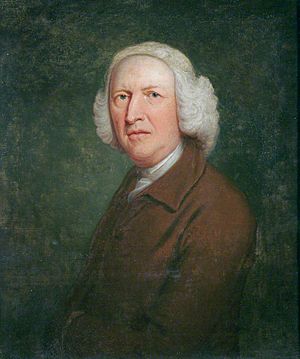Thomas Bardwell facts for kids
Thomas Bardwell (born in 1704 – died September 9, 1767) was an English artist. He was known for painting portraits of people and other scenes. He also copied famous artworks and wrote books about painting.
Life as an Artist
Thomas Bardwell started his career by painting designs for his family's business in Bungay, a town in England.
His earliest known paintings are from 1736. These include two "conversation pieces," which are paintings of groups of people talking or interacting. One of these paintings, possibly showing the Brewster family, is now in the Geffrye Museum.
In 1746, Thomas Bardwell received an important job in Norwich. He was asked to paint a portrait of William Crowe, who later became the city's mayor. This was a big deal because it meant Bardwell was the first artist to paint important city leaders in Norwich, breaking a rule that only one other artist, John Theodore Heins, could do it. Bardwell went on to paint nine portraits that were displayed in St Andrew's Hall in Norwich.
During the 1740s and 1750s, he painted many portraits in London. One famous painting from 1748 is called Joshua Ward Receiving Money from Britannia. It shows a London doctor named Joshua Ward with symbolic figures like Britannia (representing Britain) and Charity. This painting used to hang in Ward's home and is now at the Royal College of Surgeons.
Between 1752 and 1753, Bardwell traveled a lot, painting many people in Yorkshire and Scotland. He finally settled down in Norwich in 1759. After he passed away, a local newspaper called him "an important portrait painter." They said he became very skilled through his own talent and hard work.
His Book on Painting
In 1756, Thomas Bardwell published a book called The Practice of Painting and Perspective Made Easy. This book was 64 pages long and was printed in Bungay. It was dedicated to the Earl of Rochford.
The book shared his knowledge about painting. Another artist, Edward Edwards, wrote in 1808 that Bardwell's instructions on how to paint were "the best that have hitherto been published." However, Edwards thought the part about perspective (making things look three-dimensional) was not as good. A second version of the book was published in 1773.
|



